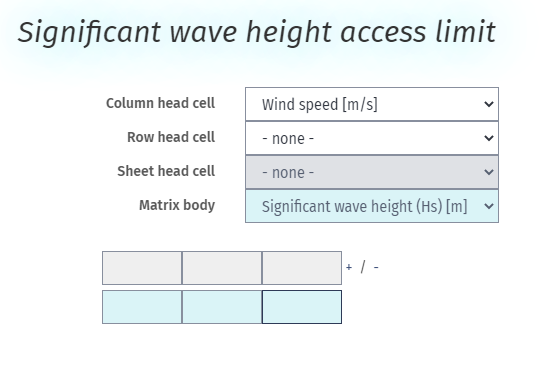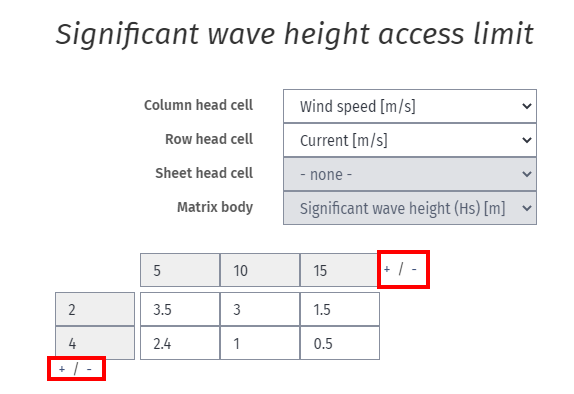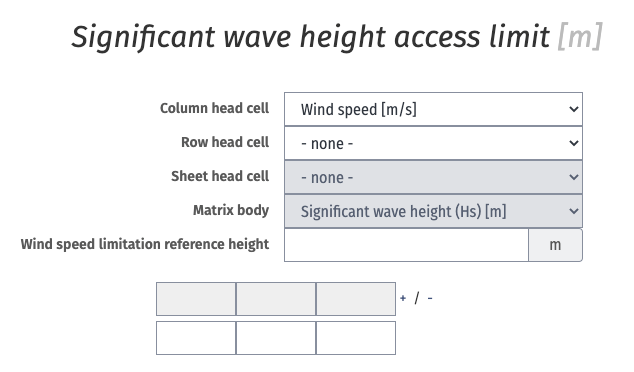Weather matrix
Weather matrices allow you to specify more detailed weather restrictions using additional parameters. To use the weather matrices throughout Shoreline Design, you must upload a weather file with the necessary criteria.
Weather matrices can be found in the following locations:
- Wind turbines: Weather criteria
- Signifcant wave height operational criteria
- Crew Transfer Vessel: Weather criteria
- Significant wave height access limit
- Towing vessel: Processes
- Heavy lift vessel: Processes
- Cable installation vessel: Processes
- Crane: Processes
- Feeder vessel: Processes
- Anchor-handling vessel: Processes
- Component transfer vessel: Processes
How to use the weather matrix
In the following example, we will use the Significant wave height access limit to show how to add a weather matrix, but the setup is the same when editing the weather matrices in the steps of a logistic process.
Your case must have a weather file that includes the required weather parameters (e.g., wind speed and wave period).
Greyed out weather data selections in the matrix mean that the weather data does not exist in the relevant weather file used in the case. To use greyed out metrics, you will have to import a new weather file that includes the relevant data.
-
Click on the Build tab of your case.
-
Click on the Logistics tab.
-
Click on the relevant logistic.
-
Click on the Weather criteria tab.
-
Click Add matrix.

-
Select the relevant criteria from the
Column head celldropdown. Optionally, select an additional criteria with theRow head celldropdown. Whether you use the second dropdown as well determines how many (1 or 2) additional weather criteria influence the wave height restriction.
-
Fill in the required data. You can then define the wave height matrix by using only the
Column head cellor bothColumn head cellandRow head cell. You can add as many cells as needed by clicking + or reduce the number by clicking -. In this example, the
In this example, the Wave height access limitis correlated to the wind speed and the current parameters, so these two parameters will define what the wave height restriction will be when those other two parameters are met.- When lower or equal conditions than 5m/s wind speed, and 2m/s current are met, the wave height restriction is 3.5m.
- When the wind speed is between 5m/s and 10m/s, and lower or equal 2m/s current conditions are met, the wave height restriction is 3m.
- When the wind speed is between 10m/s and 15 m/s, and lower or equal 2m/s current conditions are met, the wave height restriction is 1.5m.
- When wind speed is above 15m/s, the wave height restriction does not allow the logistic to operate.
- When the current is between 2m/s and 4m/s, and lower or equal 5m/s wind speed conditions are met, the wave height restriction is 2.4m.
- When the current is between 2m/s and 4m/s, and wind speed is between 5m/s and 10m/s, the wave height restriction is 1m.
- When the current is between 2m/s and 4m/s, and the wind speed is between 10m/s and 15m/s, the wave height restriction is 0.5m.
- When above 4 knots, the wave height restriction does not allow the logistic to operate.
For O&M, the engine also has the following logic: if it is above 15m/s or 4knots and there is a value in the matrix where the wave height restriction becomes 0, it will instead mean that it can do work. So if there is a 0 in the matrix body, then exceeding the values in the row or column would mean that work can be done.
-
Click Save.
You will see that the wave height criteria is defined as a weather matrix. You can edit or delete the matrix. If a weather matrix is in use, the field for defining the wave height as single number is no longer available.

In Design O&M, you can add the reference height the weather restriction corresponds to in order to extrapolate the wind speed to the same reference height as the weather limitation.
